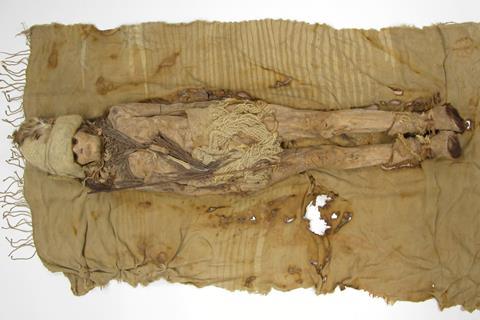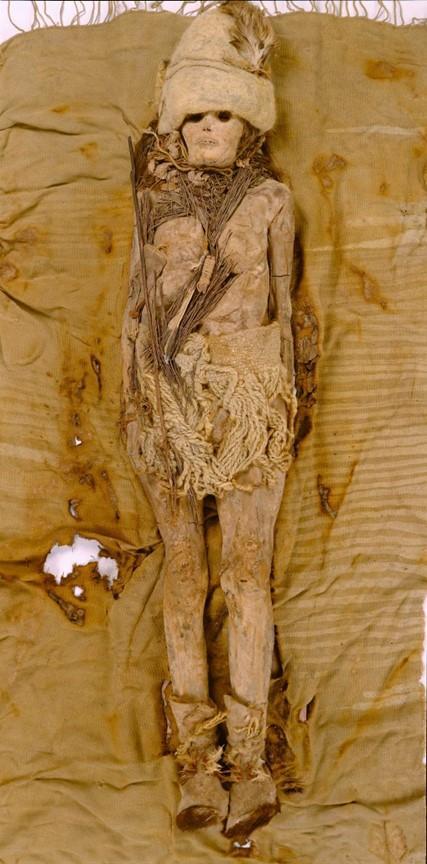For the first time, scientists successfully extracted and analyzed DNA from ancient cheese samples found alongside the Tarim Basin mummies in China, dating back approximately 3,600 years. The research, published September 25 in the Cell Press journal Cell, suggests a new origin for kefir cheese and sheds light on the evolution of probiotic bacteria.

“This is the oldest known cheese sample ever discovered in the world,” says Qiaomei Fu, the paper’s corresponding author at the Institute of Vertebrate Paleontology and Paleoanthropology, Chinese Academy of Sciences. “Food items like cheese are extremely difficult to preserve over thousands of years, making this a rare and valuable opportunity. Studying the ancient cheese in great detail can help us better understand our ancestors’ diet and culture.”
READ MORE: Uncovering the secrets of the mummy
READ MORE: AI helps mine genetic elements from ancient genomes to tackle antibiotic resistance
About two decades ago, a team of archeologists discovered mysterious white substances smeared on the heads and necks of several mummies found in the Xiaohe cemetery in Northwestern China’s Tarim Basin. These mummies dated back to about 3,300 to 3,600 years ago, from the Bronze Age. At the time, scientists thought these substances might be a type of fermented dairy product, but they couldn’t identify exactly what kind.
After more than a decade of advancements in ancient DNA analysis, a team led by Fu has unraveled the mystery.
Mitochondrial DNA
The researchers successfully extracted mitochondrial DNA from samples found in three different tombs at the cemetery. They identified cow and goat DNA in the cheese samples. Interestingly, the ancient Xiaohe people used different types of animal milk in separated batches, a practice differing from the mixing of milk types common in Middle Eastern and Greek cheesemaking.

Most importantly, Fu and her colleagues managed to recover the DNA of microorganisms from the dairy samples and confirmed that the white substances were in fact kefir cheese. They discovered that the samples contained bacterial and fungal species, including Lactobacillus kefiranofaciens and Pichia kudriavzevii, both commonly found in present-day kefir grains.
Kefir grains are symbiotic cultures containing multiple species of probiotic bacteria and yeast, which ferment milk into kefir cheese, much like a sourdough starter.
Being able to sequence the bacterial genes in the ancient kefir cheese gave the team an opportunity to track how probiotic bacteria evolved over the past 3,600 years. Specifically, they compared the ancient Lactobacillus kefiranofaciens from the ancient kefir cheese with the modern-day species.
Two major groups
Today, there are two major groups of the Lactobacillus bacteria—one originating from Russia and another from Tibet. The Russian type is the most widely used globally, including in the US, Japan, and European countries, for making yogurt and cheese.
The team found that the Lactobacillus kefiranofaciens in the samples was more closely related to the Tibetan group, challenging a long-held belief that kefir originated solely in the North Caucasus mountain region of modern-day Russia.
“Our observation suggests kefir culture has been maintained in Northwestern China’s Xinjiang region since the Bronze Age,” Fu says.

The study also revealed how Lactobacillus kefiranofaciens exchanged genetic material with related strains, improving its genetic stability and milk fermentation capabilities over time. Compared with ancient Lactobacillus, modern-day bacteria are less likely to trigger an immune response in the human intestine. This suggests that the genetic exchanges also helped Lactobacillus become more adapted to human hosts over thousands of years of interaction.
“This is an unprecedented study, allowing us to observe how a bacterium evolved over the past 3,000 years. Moreover, by examining dairy products, we’ve gained a clearer picture of ancient human life and their interactions with the world,” says Fu. “This is just the beginning, and with this technology, we hope to explore other previously unknown artifacts.”
Supporting documents
Click link to download and view these filesmummy
Other, FileSizeText 38 kb







No comments yet